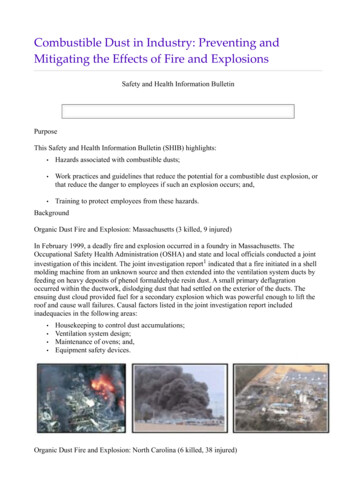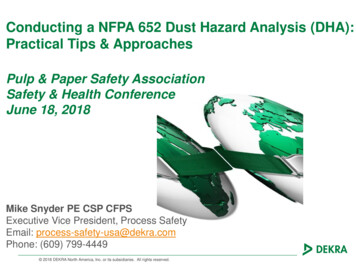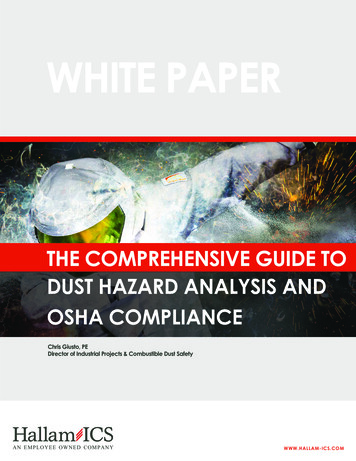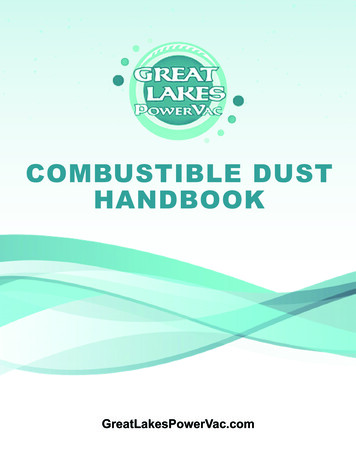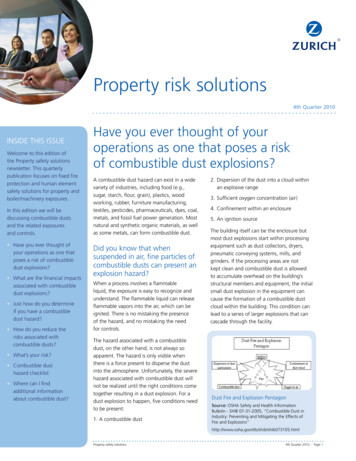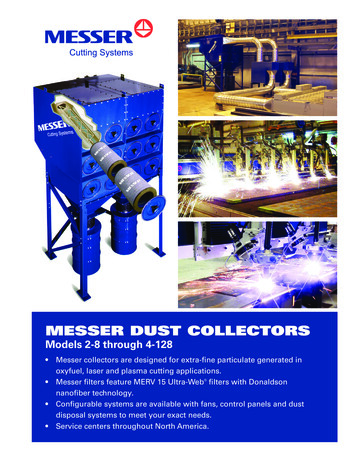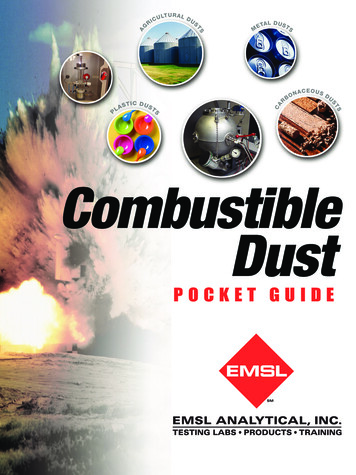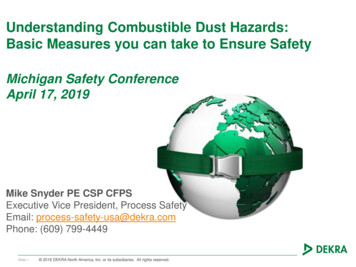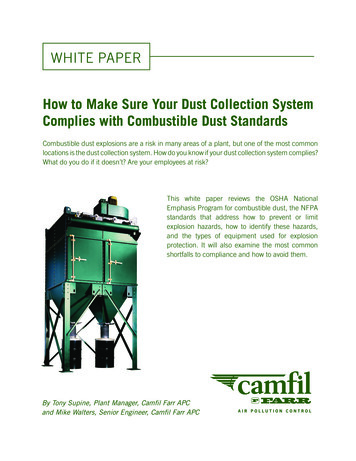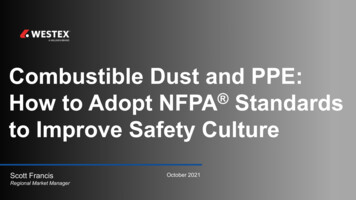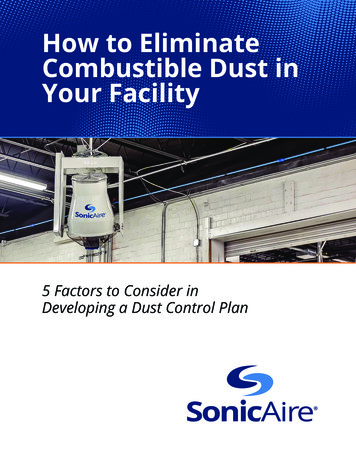
Transcription
How to EliminateCombustible Dust inYour Facility5 Factors to Consider inDeveloping a Dust Control Plan
2ContentsChapter 1 - Reducing Combustible Dust to Improve SafetyChapter 2 - NFPA 652 Dust Hazard Analysis: Is Your Company Compliant?Chapter 3 - What Is the True Cost of Combustible Dust?Chapter 4 - 5 Mistakes You May Be Making with Industrial Dust ControlChapter 5 - How Do Industrial Dust Control Fan Systems Work?SonicAire Inc.3831 Kimwell DriveWinston-Salem, NC 27103-6707 USA(336) 712-2437moreinfo@sonicaire.comwww.sonicaire.com
3Chapter 1Reducing Combustible Dust to Improve Safety119. That’s the number of workers killed bycombustible dust incidents between 1980and 2005. Another 718 were injured.These alarming stats were revealed byan extensive study conducted by the U.S.Chemical Safety Board (CSB) in 2006.By 2017, another 111 combustible dust incidents hadoccurred which resulted in an additional 66 fatalitiesand 337 injuries.In order to understand how to prevent these tragedies, onemust understand what causes a combustible dust incident.When certain elements and conditions exist simultaneously,the result can be a fatal. The scenario leading to a dustexplosion can be complex, but prevention is simple.Elimination of just one of the five elements in the CombustibleDust Pentagon makes a dust explosion impossible.The Five Elements forCombustible Dust Events1 An application that generates organic dust (i.e., wood andpaper product processing, textile processing, chemicalprocessing). In certain conditions, metals can also generate combustible dust. Over half of the incidents reportedin the 2006 CSB study occurred in the food, lumber/wood products and chemical manufacturing industries.2345 A suspended cloud of dust (dispersion) Confined conditions to trap the dust cloud (a building) Oxygen (air)A n ignition source – This can be a variety of heatsources, including any operation that produces openflames, heat or sparks (cutting, grinding, steaming,welding, soldering, etc.) Even the machinery itself,such as bearing failure, or a conveyor belt, can producea spark that can ignite a combustible dust fire.Combustibledust pentagonRisk Reduction Is Critical toEnhancing Safety PerformanceAware of this danger, facility operators are looking forsolutions to reduce their risk. Industrial dust fans haveproven to be a proactive solution that effectively preventsbuildup which could cause dust explosions and creates asafer, healthier and more efficient work environment.The effectiveness of these dust fans is based simply ontheir ability to prevent overhead dust accumulation. Bykeeping dust from building up on overhead surfaces, theneed for high-level housekeeping is virtually eliminated,and the risk of dust dispersion due to dust falling fromoverhead, which could lead to an explosion, is mitigated.Additional BenefitsAs dust control fans reduce the risk of combustible dustevents, they provide several additional health and safetybenefits to facility owners and their employees:Regulatory compliance: Due to the threat posed bycombustible dust, it is of significant concern for OSHA andNFPA. Companies that do not meet standards set by theseorganizations face severe penalties. Just last year, a metaltank manufacturer was fined 101,800 for dust accumulation related issues. Industrial dust fans are designed toprevent this accumulation and allow facility operators tocomply with government regulations.
4Safe housekeeping: Without industrial dust controlfans in place, workers must find another way to keep thefacility clean. This usually involves accessing hard-to-reachareas, which can be a dangerous task. It may also requireoperational shut-down while cleaning is completed. Dustcontrol fans accomplish these overhead cleaning chores,so workers do not have to be put at risk. This also results incost reductions, as workforce resources do not have to bediverted to time-consuming cleaning tasks, and employeescan remain productive in other areas.Improved morale: When employees are surrounded bya clean, safe environment, morale is higher. Staff enjoy abetter frame of mind, knowing they are working in aclean facility where health risks are low and safety levelsare high. This, in turn, can lead to increased productionand a healthier bottom line.A metal tank manufacturerwas fined 101,800 for dustaccumulation related issues.Manual housekeepingcan be dangerous,costly and interruptproduction.
5Chapter 2NFPA 652 Dust Hazard Analysis: Is Your Company Compliant?Is your business compliant with the requirements of NFPA 652? SonicAire can help.Here’s an overview of the updated standard and steps you can take to ensureyour operations will be in compliance with the regulations*.What is NFPA 652?This National Fire Protection Association standard outlinesthe requirements for the management of fire and explosionhazards related to combustible dusts. Updated from itsprevious version, the 2019 NFPA 652 included severalchanges. One addition for 2019 found in Chapter 7 of NFPA652 requires facilities to complete a dust hazard analysis(DHA), demonstrate progress in completing a DHA in yearsleading up to the deadline, and review and update theDHA every five years.This standard is the go-to source for facility managers,inspectors, safety personnel, contractors and engineersfor handling combustible dust safety in any industry.What is combustible dust?NFPA 652 defines combustible dust as “a finely dividedcombustible particulate solid that presents a flash firehazard or explosion hazard when suspended in air orthe process-specific oxidizing medium over a rangeof concentrations.”What is a DHA?A Dust Hazard Analysis is a facility review that examinesall areas where combustible dust is present. This analysisidentifies hazards related to explosions and fires. A DHAcategorizes each area of the facility as Not a Hazard, MightBe a Hazard, or Deflagration Hazard. If any hazard areas areidentified, the facility must define safe operating ranges, listany existing hazard management methods, and identifyadditional options to consider for future hazard management.Are you compliant?SonicAire can partner with you to prepare the overhead and hard toreach areas of your facility for NFPA compliance. Our innovativeengineering designs help prevent hazardous conditions and createa cleaner, healthier and more efficient work environment for youroperations. Our dedicated team can recommend the ideal dustcontrol system for your operations, creating a customized solutionto meet the NFPA standard and help you prevent dangerous dustexplosions at your site.* September 7, 2020 is the deadline for businesses to comply with the requirements of NFPA 652.
6Who must meet this standard?NFPA 652 pertains to all industries that includeprocesses that can generate combustible dust, althoughit specifically addresses the metal, agricultural,chemical and wood processing industries. Accordingto OSHA, the risk of combustible dust explosions ispresent in a wide range of industries, including thosethat process food, grain, tobacco, paper, rubber, dyes,plastics, pesticides, metals, pharmaceuticals and pulp.Why is this standard necessary?Between 2008 and 2012, 50 dust-related explosionincidents occurred in the United States. In the pastfour decades, more than 1,000 workers have beeninjured and another 185 killed in combustibledust events, according to OSHA. To prevent futuretragedies, the NFPA has established standards thatare designed to keep facility conditions safe. Byadhering to these requirements, facilities can reducetheir risk of deadly dust events.How can facilities comply with NFPA 652?NFPA 652 includes hazard management steps formitigation and prevention. These sections coverseveral topics, including guidelines for housekeeping,equipment design and continuous dust control.Included here are industrial dust control fans such asthose made by SonicAire. (See NFPA 652 Chapter 9.)This engineered solution is the ideal option fororganizations seeking to improve housekeeping andalign their practices with NFPA standards. By installingthese dust control fans, facilities can quickly bringtheir high-dust areas into compliance with NFPAstandards. Because these standards are used byOSHA as part of their inspection requirements,adhering to NFPA guidelines will not only increasesafety, but it will also prevent steep fines which canbe assessed by OSHA.Excerpt from NFPA 652 Chapter 9.
7Chapter 3What Is the True Cost of Combustible Dust?Webster defines cost as “an amount that hasto be paid or spent.” This concise definitiondescribes a simple transaction. I pay x for y.But when it comes to combustible dust, thecost isn’t this straightforward. To count thetrue cost, we have to dig a little deeper.Immersed in a world of business transactions, it can beeasy to focus on the up-front cost of maintenance andsafety measures regarding combustible dust. Facilitymanagers consider the cost of cleaning services andmaintenance equipment. The costs that are lessstraightforward can get lost in the dust, so to speak.If we zoom out and take a more comprehensive look atcombustible dust, we see that the true cost can befar greater than that of proactive measures to controlcombustible dust issues.Monetary CostOSHA standards address combustible dust hazards, settingguidelines for safe work environments. Facilities mustadhere to OSHA regulations to avoid hefty fines. Some ofthese regulations are industry specific, while others aregeneral practices. Many states have state-wide occupationaland safety programs that address these standards.According to the Solicitor of Labor, Federal OSHA conducted476 inspections in 2017 related to combustible dust.These inspections resulted in 319 citations.Cost ofCombustibleDustFines/PenaltiesOver the past several years, companies have discoveredjust how severe these citations can be. In 2014, OSHAinspected a lumber manufacturer in Georgia anddiscovered a build-up of combustible dust and repeatviolations. The company was fined 279,400. That sameyear, OSHA fined a processing and packaging company 254,000 for “exposing workers to combustible dust.”Not all fines have been this high. In 2018, a metaltank manufacturer was fined “only” 101,800 for dustaccumulation. Still others have been much higher.A grain processing facility in Cambria, Wisconsin,suffered a dust explosion in 2017 that resulted in 1.8 million in OSHA fines.Production Cost Production LostWhile costly, fines aren’t always the worst consequenceof combustible dust. If appropriate steps are not taken tocontrol the dust, a facility may experience a combustibledust explosion or fire.These events can shut down production for a few hours, afew days, or forever. With each passing minute of downtime, valuable production time is lost. Even minor incidentscan cause damage that requires significant downtime forrepairs.Consider the math. If your facility makes 600 units per hourat an average selling price of 50 each, your companyloses 30,000 in revenue for every hour of downtime. Thegreater the scale of production, the greater the loss. Forexample, the average automotive manufacturing plant losesmore than 20K per minute of downtime.LostProductionSafetyIncidents/Injuries
8While proactive measures to control combustible dust mayrequire a degree of lost production up front, this cost issmall compared to that of recovery from a combustibledust explosion.Ultimate CostLost production is expensive but examining this cost stilldoesn’t cover the full impact of combustible dust. Too often,when facilities experience a combustible dust event, peopleare injured, and lives may be lost.The Chemical Safety and Hazard Investigation Board (CSB)reports 66 fatalities and 337 injuries due to combustibledust incidents occurred in the U.S. between 2006 and2017. In 2017 alone, 237 combustible dust explosions andfires around the globe injured 163 and killed 13.While awareness of the dangers of combustible dust hasgrown in recent years, these incidents continue. In Septemberof 2019, a dust explosion at a cosmetics plant in NewJersey left a worker seriously injured, another dust incidentat a spice manufacturer in the Netherlands injured three,and a dust explosion at a German woodworking facilityinjured one employee.
9Chapter 45 Mistakes You May Be Making with Industrial Dust ControlNews coverage of combustible dust incidents and heightened standards for dust controlhave increased the awareness of industrial dust hazards. Yet, some common misconceptionsregarding this key safety issue continue to circulate.These misconceptions can cause facility managers tomake critical mistakes with their industrial dust controlprocedures. Following are five of the most common.1. Out of Sight, Out of MindThis adage often refers to people or objects, and it canapply to industrial dust as well. If dust is located in out-ofthe-way areas, the issue of combustible dust hazards candrop off your radar. And this can prove disastrous.The mistake some facility managers make is to assumethat the dust is not a problem because they can’t seeit. “It’s out of sight, so it doesn’t affect my operations oremployees.” This couldn’t be further from the truth. Similarto that is the assumption, “It can’t happen here.” Lack ofhazard awareness can contribute to how employees reactwhen they observe dust.In fact, this dust is often located in spaces that aren’treadily visible. This is part of what makes it so dangerous.The industrial dust builds up without notice and becomes apotential hazard. Then, without warning, it can contribute toa combustible dust explosion or fire, which can spread toall areas of the facility.2. Manual Methods Are SufficientManual housekeeping measures may prove helpful tomaintaining plant safety. Typically, however, they are notenough to properly maintain a safe environment. They alsoinvolve risks that can be dramatically underestimated whenfacility owners calculate the cost of cleaning efforts.First, manual methods can put workers at risk. Accessinghard-to-reach areas may require climbing to dangerousheights and using complex harnesses or unfamiliarmachinery. If injuries occur during manual cleaning, thecompany could face litigation. Lawsuits are also possibleif the manual methods are ineffective and an explosioncauses injuries or deaths.Second, manual housekeeping methods require significantinvestment of resources. Not only do facility owners haveto allocate budget to cleaning supplies, equipment andpersonnel, but they may also suffer from lost productionif downtime for cleaning is required beyond normalshutdowns. All of this adds up to significantly more costand risk than many business owners realize.Finally, some manual cleaning methods may actuallyworsen the dust issue rather than improve it. For example,using compressed air or steam to clean surfaces can riskshifting dust to other areas of the facility. According toOSHA, “if compressed air or steam must be used, it is vitalto first ensure that potential ignition sources in the vicinityare eliminated and apply the air or steam only under lowpressure to avoid disbursing clouds of dust to other areas.”
103. We Don’t Make Very Much Dust“I’m not making that much dust. I’m sure we could passany inspection.” Making this assumption is a mistake—and it can be a costly one. You might be surprised howlittle dust can warrant OSHA action. This agency adheresto standards set by the National Fire Protection Agency(NFPA). According to the NFPA, an accumulation of as littleas 1/32” of dust can be hazardous. That’s the thickness ofa single paper clip.It’s also important to consider the variability of industrialdust. OSHA reports that two dusts made of the samematerial can pose different risks for ignition and explosionbased on their shape, size and moisture content.Additionally, these dust traits can shift during processingand manufacturing. The result: dust that you thought wasminimal or benign could be dangerous after all.If OSHA determines you are in violation, you could pay ahefty price. OSHA penalties range from 5,000 to 70,000per violation. Case in point: In August 2019, OSHA listedcombustible dust among the safety and health hazardspresent at a manufacturer of electronic enclosures. Thecompany now faces 161,020 in penalties.4. OSHA Won’t NoticeA second OSHA-related mistake is to assume this agencywill not inspect your facility. While some locations may bemore likely than others to undergo inspection, it is not wiseto assume an agent will never arrive on your doorstep.In 2017, OSHA conducted 476 inspections related tocombustible dust. These resulted in 319 citations.How likely are you to be among these numbers in thefuture? OSHA prioritizes by hazard level. Imminent dangersituations top the list, followed by reported injuries andillnesses, worker complaints, referrals from other agencies,and, lastly, specific high-hazard industries.Your facility might not fit the bill for imminent danger,but if OSHA receives any complaint or notice about thecondition of your facility, an inspection could be imminent.And even if combustible dust issues don’t instigate theinspection, if they are discovered during the process, youcould face penalties.5. Dust Collectors Will Do the TrickAs with manual housekeeping measures, dust collectorsplay an important role in industrial dust control, but theyare not 100% effective. These devices can miss some ofmachine- and floor-level dust as well as airborne dust thatthen settles and accumulates in overhead areas.One Pennsylvania-based wood pellet manufacturer’sfindings demonstrate the significance of this less-thanperfect system. The operations manager reports, “Even ifwe contained 99.99% of the dry dust going into the pelletmill, that would still lead to over 130 pounds of dry dustbecoming airborne per week from each pellet mill.”With this much dust accumulation possible, additionalmethods are necessary to reduce the risk of combustibledust events.
11Chapter 5How Do Industrial Dust Control Fan Systems Work?For industrial plants, one by-product of operations is inevitable: dust. In many settings, this otherwiseharmless debris can pose serious threats to the safety of the facility. Industrial dust control fansare designed to eliminate this danger in overhead and hard to reach areas of the facility.How? Industrial dust control fan systems provide aproactive solution that prevents dust from accumulating inthe first place. They are designed and arranged to providemaximum cleaning power that keeps plants clean and safe.This design involves three key components.1. Proprietary TechnologySonicAire industrial dust control fans use BarrierAire technology. The fans’ operation forms an air barrier thatkeeps dust, lint and fibers at the floor level of a facility.This technology uses two methods to control dust flow: T hermal-current control: Typical airflow includes themovement of thermal currents which naturally bring dustinto the air. Upward currents carry particles to overheadareas of facilities, where dust quickly accumulates andcan become a fire hazard. Industrial dust control fansprevent these upward thermal currents from holdingdust in the air. H igh-velocity airflow: The fans use high-velocityairflow to keep overhead areas clean. The strengthof this airflow effectively prevents the accumulation ofcombustible dust particles on overhead structures inthe plant. Areas that used to be covered in cobwebsand dust blankets are kept clean by the fans’effective operation.How industrial dust control fans work: Strategic fan placementcreates an air barrier that keeps dust, lint and fibers at floor levels ofa facility. Using thermal current control and high-velocity airflow, thefans keep overhead areas clear of dust and prevent upward thermalcurrents from holding dust in the air.
12Before installation of a SonicAiredust control fan system.After installation and use of a SonicAire dust controlsystem to clear away combustible dust.2. Strategic Installation3. Impressive ResultsIndustrial dust control fans are arranged to maximizecleaning and minimize the number of fans required for theplant. This strategic installation involves three elements:Industrial dust control fans effectively direct dustdownward where it can be cleaned using regular low-levelhousekeeping methods. As a result, facilities can: E ngineered application: Industrial dust control isbased on the size and shape of the plant, its processesand any other variables that can affect the accumulationof combustible dust. To achieve maximum results, aknowledgeable system engineer, familiar with thedynamics of plant airflow, the nature and type of dust,dust accumulation, potential hazards and employeesafety considerations, will design a system to meetthe specific requirements of the plant. The design willinclude the recommended fan equipment, placementand accessories for optimal performance. A dhere to government regulations. Industrial dustcontrol fans allow plant operators to clean structuralsupports, pipes, ducts, process equipment and otherhard-to-access areas to meet or exceed governmentregulations. The fans help keep plants in compliancewith relevant OSHA and NFPA regulations concerningcombustible dust. E xpert set-up: Once the system is designed foreffective results, it is installed by a contractor or byplant operations. F an controls: SonicAire offers a variety of controlfeatures to automate fan operation, integrate with firealarm systems, coordinate with plant processes andstrategically modify the speed and performance of thefans for maximum efficiency. P rovide a safer employee environment. Industrialdust control fans are designed to prevent combustibledust accumulation. This reduces the risk of fires andexplosions and creates cleaner air, effectively improvingthe health and safety of the work environment. Employeesafety and morale is further enhanced by eliminating theneed for workers to clean areas that can be dangerousto access. R educe labor costs. Manually cleaning hard-to-accessareas is a time-consuming task. It also takes workersaway from other duties and may require shutting downoperations while the chore is completed. Industrial dustcontrol fans are designed to eliminate the need forthis manual cleaning, effectively reducing labor costsand boosting a plant’s bottom line. In some cases, thefan systems can pay for themselves in the first yearof operation.
131234Example layout showing how a SonicAire dust controlsystem can be implemented.Industrial dust control fans offer a proactive solution for awide range of manufacturing and processing industries,including wood, furniture, cabinets, paper, textiles, nonwovens, laundry, plastics, recycling, rubber and chemicaloperations. The versatility of the various fan models makesthis an effective option for facilities of all sizes.SonicAire’s BarrierAire technology keeps dust at the floorlevel of the facility, preventing overhead dust accumulationand combustible dust cloud formation. Each system isinstalled based on an engineered analysis and plan for yourfacility (see example above). The fans can be programmedfor custom rotation and oscillation ranges specific to eachlocation, ensuring optimal performance.
Reap the Benefits of IndustrialDust Control Fan SystemsSonicAire partners with plant operators tominimize risk and enhance safety. Our proactivedust control solution is designed to preventoverhead combustible dust problems while ourteam delivers a customized solution for eachfacility that maximizes results while minimizingcost. The results are a cleaner, safer plant thatenables you to maintain productivity whilecomplying with industry regulations.To learn more, including how an engineered dust controlsystem may be the right solution for you and to requesta free assessment, please contact SonicAire.Specifications and information subject to change without notice and without liability therefor. Trademarks are property of their respective owners.0320SonicAire Inc.3831 Kimwell DriveWinston-Salem, NC 27103-6707 USA(336) 712-2437moreinfo@sonicaire.comwww.sonicaire.com
Reducing Combustible Dust to Improve Safety 119. That's the number of workers killed by combustible dust incidents between 1980 and 2005. Another 718 were injured. These alarming stats were revealed by an extensive study conducted by the U.S. Chemical Safety Board (CSB) in 2006. By 2017, another 111 combustible dust incidents had
